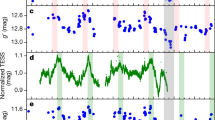Abstract
ACCRETION disks1,2 are found in many astrophysical objects, ranging from newly formed stars and mass-transferring binary systems to quasars and other active galactic nuclei. An important feature of accretion disks is the boundary layer—the interface between the disk and the accreting objects—where up to half the accretion luminosity may be liberated. The lack of a satisfactory description of the flow and thermal structure of this layer has long been a handicap when modelling disk spectra. Here we report numerical solutions of a model of thin accretion disks around a central white dwarf which includes a self-consistent description of the boundary layer. We find two distinct kinds of solution depending on the mass accretion rate Ṁ. At high rates, we find optically thick boundary layers whose radial width and peak temperature decrease with decreasing Ṁ, but when the accretion rate falls below a critical value, the boundary layer becomes optically thin, and the width and temperature increase dramatically. Our results provide an explanation for the hard X-rays observed3 in cataclysmic variables, particularly at low Ṁ. It should be possible to extend our analysis to other accretion-disk systems.
This is a preview of subscription content, access via your institution
Access options
Subscribe to this journal
Receive 51 print issues and online access
$199.00 per year
only $3.90 per issue
Buy this article
- Purchase on Springer Link
- Instant access to full article PDF
Prices may be subject to local taxes which are calculated during checkout
Similar content being viewed by others
References
Shakura, N. I. & Sunyaev, R. A. Astr. Astrophys. 24, 337–355 (1973).
Pringle, J. E. A. Rev. Astr. Astrophys. 19, 137–162 (1981).
Patterson, J. & Raymond, J. C. Astrophys. J. 292, 535–549 (1985).
Popham, R. & Narayan, R. Astrophys. J. 370, 604–614 (1991).
Paczynski, B. Astrophys. J. 370, 597–603 (1991).
Narayan, R. Astrophys. J. 394, 261–267 (1992).
Popham, R. & Narayan, R. Astrophys. J. 394, 255–260 (1992).
Paczyóski, B. & Bisnovatyi-Kogan, G. Acta astr. 31, 283–291 (1981).
Muchotrzeb, B. & Paczynski, B. Acta astr. 32, 1–11 (1982).
Abramowicz, M. A., Czerny, B., Lasota, J. P. & Szuszkiewicz, E. Astrophys J. 332, 646–658 (1988).
Hubeny, I. Astrophys. J. 351, 632–641 (1990).
Tylenda, R. Acta astr. 31, 267–281 (1981).
Regev, O. Astr. Astrophys. 126, 146–151 (1983).
Patterson, J. & Raymond, J. C. Astrophys. J. 292, 550–558 (1985).
Sunyaev, R. A. & Trumper, J. Nature 279, 506–508 (1979).
McClintock, J. Ann. N. Y. Acad. Sci. 647, 495–502 (1991).
Rees, M. J. A. Rev. Astr. Astrophys. 22, 471–506 (1984).
Shapiro, S. L., Lightman, A. P. & Eardley, D. M. Astrophys. J. 204, 187–199 (1976).
Bertout, C., Basri, G. & Bouvier, J. Astrophys. J. 330, 350–373 (1988).
Hartigan, P. et al. Astrophys. J. 382, 617–635 (1991).
Author information
Authors and Affiliations
Rights and permissions
About this article
Cite this article
Narayan, R., Popham, R. Hard X-rays from accretion disk boundary layers. Nature 362, 820–822 (1993). https://doi.org/10.1038/362820a0
Received:
Accepted:
Issue Date:
DOI: https://doi.org/10.1038/362820a0
This article is cited by
Comments
By submitting a comment you agree to abide by our Terms and Community Guidelines. If you find something abusive or that does not comply with our terms or guidelines please flag it as inappropriate.



